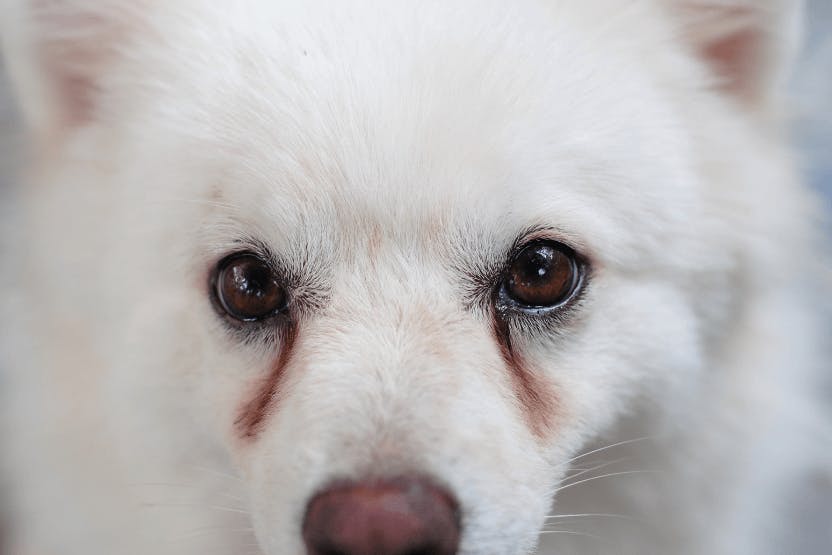
By Emily Bayne
Published: 06/20/2017, edited: 12/29/2023
Reviewed by a licensed veterinary professional: Dr. Linda Simon, MVB MRCVS
Save on pet insurance for your pet
You don't have to choose between your pet and your wallet when it comes to expensive vet visits. Prepare ahead of time for unexpected vet bills by finding the pawfect pet insurance.
Overview
Tear stains in dogs are most often caused by tear over-production, but can also be caused by other factors such as allergies, environment, nutrition, and yeast infection. It is most visible in light-colored dogs. Tear staining is usually a controllable issue, but the underlying cause can lead to infection if neglected. As always, the best avenue to take is to consult your vet about what specific treatment would work best for your pet and go from there. The following information can help you brainstorm ways in which to treat tear stains with your dog in order to help your dog live a happy, healthy life.
Color Matters
The color of the stains can be an important indicator in the causation of this health issue. If the stains are rust or red in color, this is usually caused by numerous environmental issues such as allergies, diet, and stress. If the stain tends to be more brown in color, this can be an indicator of a yeast infection, which is also caused by diet, but is a little bit of a different issue. If your dog’s face smells along with tear staining, this is a definitive sign that you should check with your vet about a yeast infection.
Prevention
There are many ways to prevent tears stains from occurring in the first place.
If you own a light-colored dog, they are much more susceptible to this condition, and prevention is a great way to avoid the issue before it starts. Water quality can be a cause, as well as feeding or watering in metal bowls.
You can filter your water to prevent bacterial buildup, and change your bowls to stainless steel, glass or ceramic instead of plastic as they easier to clean and prevent antimicrobial growth. As with any nutrition issue, it is a good practice to know the ingredients in your pet food. Believe it or not, your dog’s diet can be a big factor in whether they develop tear stains or not.
Food Additives
Apple cider vinegar has many uses with humans and pets. As a food additive (about 1 teaspoon in food), apple cider vinegar can be a good way to clear up those pesky tear stains. If you have ever taken apple cider vinegar yourself, you know that it is very bitter to the taste. While feeding it to your pet, you will definitely need to mix it in with some type of soft or wet dog food.
Topical Treatment
As with any infection of this kind, keeping the area clean and dry is important. This is a cheap and easy way to begin. Be very careful to avoid getting any kind of substance in your dog’s eyes. If you do not already have your dog professionally groomed, you can trim the stray hairs around their eyes to reduce areas for the matter to rest. Dog eye drops are always an option, just make sure to check the brand with your veterinarian in order to avoid any added allergens.
In the past year, there have been many allegations against dog tear stain products. Some of these products do have the potential to hurt your dog rather than helping. When choosing the brand and product, be very careful. Use your veterinarian as a resource to choose what is right for your dog. Read the reviews do your research before choosing any type of application for this condition.
Know When to Look Deeper
Tear staining in dogs can be an unsightly issue for your dog, but it can also become a more serious condition in some situations. This condition can easily be an indicator of your dog’s overall health. You know your dog best. Look for signs of discomfort or odd odors. There are many ways to help your dog overcome tear staining, it might just take some trial and error, along with the consultation of your veterinarian to find the right combination of treatments.
If your dog is prone to tear stains, underlying medical conditions may be at play. Conditions like 'Dry Eye', entropion and environmental allergies must all be considered.
If your dog is at risk of developing tear stains, check out our pet insurance comparison tool. See how insurance plans from leading companies like Figo and Healthy Paws compare so you can choose the right policy for your pet!
You may also like
